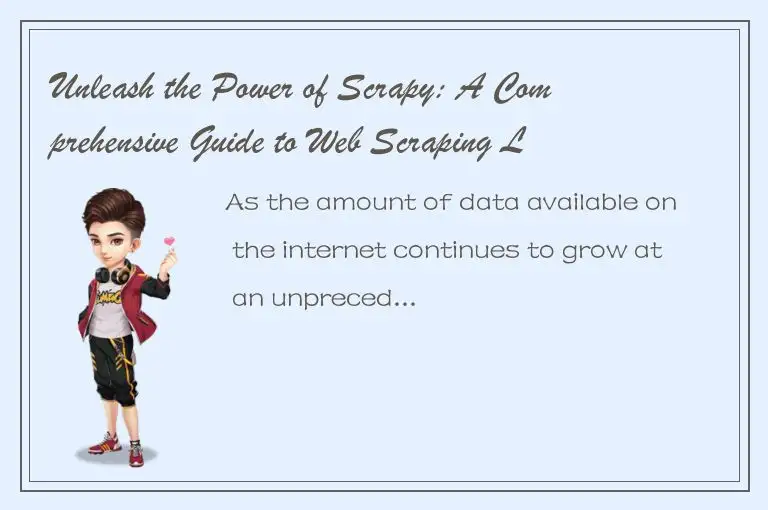As the amount of data available on the internet continues to grow at an unprecedented pace, web scraping has become an essential tool for data analysts, researchers, and businesses alike. And when it comes to web scraping, Scrapy is indisputably one of the most powerful and flexible frameworks available today.

In this comprehensive guide, we'll take a deep dive into Scrapy and explore how you can harness its full potential to extract data from the web with ease and efficiency. Whether you're a seasoned developer or a newcomer to the world of web scraping, you'll learn everything you need to know to get started using Scrapy like a pro.
Part 1: Getting Started with Scrapy
Before we dive into the more advanced features of Scrapy, let's start by installing and setting up the framework on your system. Here are the steps you'll need to follow:
1. Install Python
Scrapy is built using Python, so you'll need to have the language installed on your system before you can use the framework. You can download and install Python for free from the official website.
2. Install Scrapy
Once you have Python installed, you can install Scrapy using pip, which is the standard package manager for Python. Open your terminal or command prompt and enter the following command:
pip install scrapy
This will download and install the latest version of Scrapy on your system.
3. Setting up your first Scrapy project
Now that you have Scrapy installed, it's time to create your first project. Open your terminal or command prompt and enter the following command:
scrapy startproject tutorial
This will create a new directory called "tutorial" that contains the basic structure for a Scrapy project. You can modify the files in this directory to customize your project as needed.
Part 2: Extracting Data with Scrapy
Now that you have your Scrapy project set up, it's time to start extracting data from the web. Here's how you can do it using Scrapy:
1. Creating a Spider
Spiders are the heart of Scrapy. They are python classes that define how to extract data from a website. To create a spider, open the spiders directory within your Scrapy project directory and create a new file called "quotes_spider.py" (for example).
In this file, define a scrapy.Spider class that inherits from scrapy.Spider. Here's an example to get you started:
import scrapy
class QuotesSpider(scrapy.Spider):
name = "quotes"
start_urls = [
'http://quotes.toscrape.com/page/1/',
'http://quotes.toscrape.com/page/2/',
]
def parse(self, response):
for quote in response.css('div.quote'):
yield {
'text': quote.css('span.text::text').get(),
'author': quote.css('span small::text').get(),
'tags': quote.css('div.tags a.tag::text').getall(),
}
This spider extracts data from the popular site "quotes.toscrape.com". The spider starts by visiting two pages and extracts the quote text, author name and tags. The data is then returned in a dictionary format.
2. Running the spider
To run the spider, open your terminal or command prompt and navigate to your Scrapy project directory. Then enter the following command:
scrapy crawl quotes
This will run the spider and extract the data from the website. The data will be displayed in your terminal window.
Part 3: Advanced Scrapy Features
Scrapy offers a wide range of advanced features that allow you to extract data from the web with even greater precision and efficiency. Here are some of the most useful features:
1. Item pipelines
Item pipelines allow you to process the data extracted by your spider before it is stored. For example, you can use pipelines to clean up the data, remove duplicates, or store it in a more convenient format.
To create a pipeline, open the settings.py file in your Scrapy project directory and add the following lines:
ITEM_PIPELINES = {
'tutorial.pipelines.QuotesPipeline': 300,
}
This will create a pipeline that processes the data extracted by your spider using the QuotesPipeline class.
2. Link extractors
Link extractors allow you to extract links from a website that your spider can follow to extract even more data. Here's an example:
from scrapy.linkextractors import LinkExtractor
class QuotesSpider(scrapy.Spider):
name = "quotes"
allowed_domains = ['toscrape.com']
start_urls = ['http://quotes.toscrape.com/']
rules = (Rule(LinkExtractor(), callback='parse_item', follow=True),)
def parse_item(self, response):
yield {
'text': response.css('span.text::text').get(),
'author': response.css('span small::text').get(),
'tags': response.css('div.tags a.tag::text').getall(),
}
This spider extracts data from the "quotes" section of the site, and follows all links to other pages.
3. Custom settings
Finally, you can customize the settings for your Scrapy project to further refine your data extraction. For example, you can set the user agent for your spider, configure delays between requests, or limit the number of concurrent requests.
To customize the settings, open the settings.py file in your Scrapy project directory and modify the appropriate settings.
In Summary
Scrapy is a powerful and flexible framework that allows you to extract data from the web with ease and efficiency. With its broad range of features and customization options, Scrapy is an excellent tool for data analysts, researchers, and businesses alike. By following the steps outlined in this guide, you'll be well on your way to mastering the art of web scraping with Scrapy.




 QQ客服专员
QQ客服专员 电话客服专员
电话客服专员